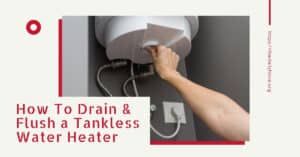If your gas-powered water heater will not stay lit, it is most likely due to a faulty thermocouple. It is a safety device that shuts off the gas supply if the pilot light becomes extinguished, thus preventing a buildup of gas and a possible explosion. Below is more information on the role played by thermocouples in water heaters, how you can check one for trouble and replacement.
What a thermocouple does?
A thermocouple is a simple device consisting of two dissimilar metals that generate an electrical current in heat. Water heaters utilize this electricity to operate an internal gas safety valve that shuts off the gas flow during a pilot light outage. In addition, the electrical current can be used to power thermostats and provide other functionality.
When a thermocouple becomes dirty or fails entirely, the electrical current stops flowing, and the water heater will not stay lit; this is intentional to prevent a possible gas buildup and explosion. Fortunately, thermocouples are easy to test, clean, and replace; below is how to do it.
Tools and materials needed:
- Screwdriver
- Electrical multimeter
- Fine grit sandpaper
- Adjustable wrench
Step-by-step procedure to test, clean, and replace a water heater thermocouple.
1. Locate and remove the thermocouple connection to the thermostat.
The thermocouple flame sensor is located inside the water heater’s burner assembly. The sensor is attached to a copper wire leading from the burner to the thermostat on the unit’s exterior. To remove, simply turn the thermocouple fitting until it unscrews from the thermostat; in some cases, you may need to use an adjustable wrench to loosen the fitting. Carefully pull the connector from the thermostat.
Test
2. Test the thermocouple.
Once the connector is removed from the thermocouple, you can measure the voltage output with a multimeter. Set the multimeter to read direct current (DC) at the milli-volt level. Next, attach the meter’s positive (red wire) lead to the bare exterior wire and thermocouple flame sensor, and then connect the negative (black wire) to the connector you just removed from the thermostat. Look at the meter’s display and note that it should be at zero or just a fraction above it.
While holding the multimeter and thermocouple in a convenient location, press and hold the water heater ignition button for one minute. The pilot light should ignite immediately; at the same time, glance at the multimeter display for voltage output. A normal-functioning thermocouple will slowly rise in voltage. A flawed device will either stay static at zero or rise just a slight amount.
3. Remove the thermocouple from the water heater.
If the thermocouple reading is not normal, then it needs to be removed. Since this procedure involves opening up the water heater burner chamber, the gas supply must be shut off for safety reasons. The gas supply is controlled by an inline valve usually turned in a perpendicular direction to the line; this indicates the supply is off.
After turning off the gas, remove the screws holding the burner assembly to the remainder of the tank. Set them aside in a safe location, and disconnect any other wires or tubing leading from the burner assembly to the thermostat; in many cases, these connections include the pilot light gas supply tube, main gas supply tube, and igniter switch. Once the screws and other connections are removed, slowly slide the burner assembly from its location and remove it from the tank.
Clean
4. Inspect and clean the thermocouple.
Take a close look at the burner assembly, and you will see the pilot light burner tube. It will be located next to the thermocouple flame sensor.
Slide a piece of fine-grit sandpaper down into the space surrounding the flame sensor and other components, and lightly rub the sensor with the sandpaper to remove soot and other accumulations. Try to keep your rubbing light so that you don’t accidentally damage the sensor.
Replacement
After detaching the thermocouple from the burner, take the thermocouple to your local hardware and buy a replacement. Install the new one by pushing the end of the new thermocouple into the pilot assembly and then reattach the thermocouple to the pilot gas supply using the clips, refit the burner assembly and reconnect the thermocouple lead using a wrench, reconnect the thermocouple lead, the pilot gas tube to the valve and the gas tube to the main burner.
5. Restore and test.
Following in reverse order from steps four and above, reassemble the thermocouple and its parts. Restore gas power to the heater and test the heater for proper ignition and flame maintenance.
Ensure that you check for gas leaks. Do this while the main burner is alight. Apply soapy water to joints and look for bubbles; if you see any, switch off the gas supply and fix the cause of the leak.
What does it cost to replace thermocouple on water heater?
A water heater thermocouple replacement costs around $5 to $10. Remember to purchase a replacement before starting trouble. They are available from hardware stores such as Amazon or Home Depot.






